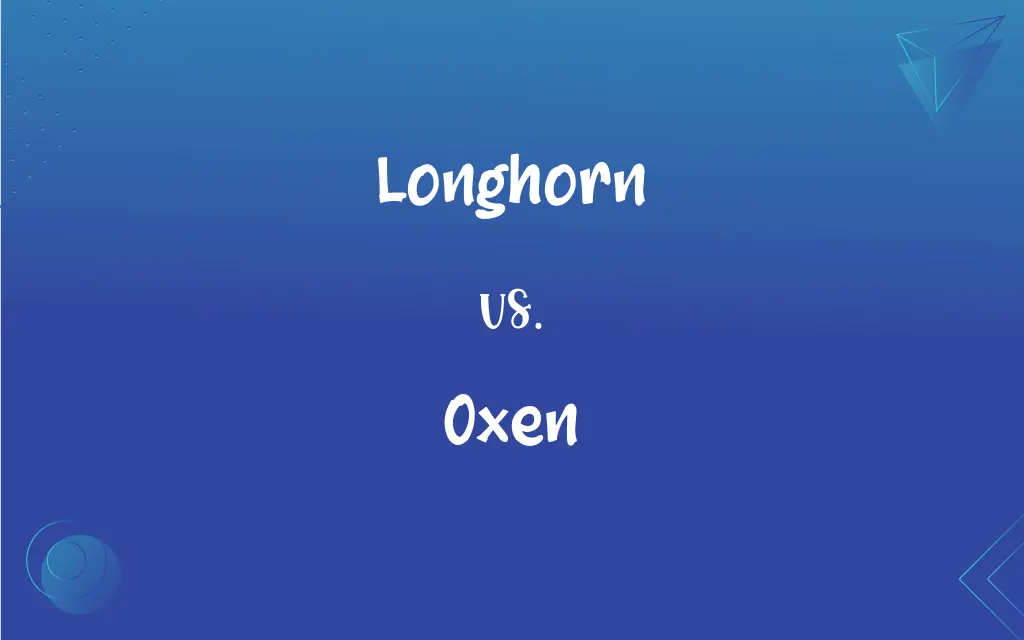Longhorn vs. Oxen: What's the Difference?
Edited by Aimie Carlson || By Janet White || Updated on October 2, 2023
Longhorn refers to a breed of cattle known for long horns, while oxen are adult castrated male cattle, typically used as draft animals.

Key Differences
Longhorn and Oxen refer to different classifications within the cattle family. A Longhorn is a specific breed of cattle known for its distinctive long horns and is often associated with the imagery of the American West. They are usually kept for their beef, which is leaner compared to other cattle breeds. In contrast, Oxen are adult castrated male cattle, used primarily as draft animals to plow fields, pull carts, and carry heavy loads, contributing significantly to agricultural practices and transportation.
Diving into the physical aspects, the Longhorn’s identifying feature is, as the name suggests, its exceptionally long, curved horns which can extend up to seven feet. These cattle are recognized for their hardiness and ability to adapt to challenging environments. Oxen, on the other hand, are known for their strength and stamina, which make them suitable for heavy labor. They are not defined by any specific physical characteristics or breeds but rather by their role and utility in work and agriculture.
Discussing historical importance, Longhorns have played a pivotal role in the cattle industry, symbolizing the Old West. They have been integral to the development of the cattle trade in North America. Conversely, Oxen have a broader historical significance worldwide, having been used across different cultures and civilizations for thousands of years as a source of power in agriculture and transportation, prior to the invention of modern machinery and vehicles.
While Longhorns are primarily raised for beef production and are valued for their lean meat, Oxen are seldom used for meat, as they are more valuable as working animals. The distinction between Longhorns and Oxen is not based on breed or physical appearance but is more about the purpose and functionality of the animals.
The differentiation between Longhorn and Oxen is thus clear; Longhorns are recognized as a distinct breed notable for their characteristic horns and resilience, while Oxen are identified by their role as robust and reliable working animals, contributing significantly to human agricultural practices and transportation.
ADVERTISEMENT
Comparison Chart
Definition
A breed of cattle with distinctive long horns.
Adult castrated male cattle used as draft animals.
Purpose
Primarily raised for beef.
Used for labor in agriculture and transportation.
Characteristics
Known for long, curved horns and hardiness.
Known for strength and stamina.
Historical Role
Symbolizes the American West.
Have been used worldwide for thousands of years.
Utilization
Valued for lean meat.
Valued more for labor than meat.
ADVERTISEMENT
Longhorn and Oxen Definitions
Longhorn
Distinguished by adaptability and lean beef.
The Longhorn cattle easily adapted to the harsh climates of the West.
Oxen
Often yoked in pairs.
A pair of oxen were yoked together to pull the plow efficiently.
Longhorn
Prized for unique horn shapes and sizes.
Each Longhorn has a unique horn curvature and length.
Oxen
Adult, castrated male cattle used for labor.
Oxen have been essential for plowing fields in agrarian societies.
Longhorn
Has high drought-stress tolerance.
The Longhorn can survive in arid regions with minimal water.
Oxen
Utilized worldwide as draft animals.
Different cultures have utilized oxen for transportation and agriculture.
Longhorn
A breed of cattle known for their long horns.
The Longhorn is iconic to Texas and the American West.
Oxen
Valuable in pre-industrial agricultural societies.
Before the advent of tractors, oxen were indispensable in farming.
Longhorn
Represents the historic cattle industry of the American West.
The Longhorn cattle drives were central to the old American West.
Oxen
Known for strength and endurance.
Oxen can pull heavy loads for long distances without tiring easily.
Longhorn
Any of a breed of cattle with long horns and a brown and white coat, developed in England for meat and milk and now rare.
Oxen
Plural of ox.
Longhorn
A Texas Longhorn.
Oxen
Plural of ox
Longhorn
Any of various cow's milk cheeses, usually Colby or Cheddar, that are molded into a long cylinder and often cut into moon or half-moon shapes for sale.
Oxen
Of, relating to, or resembling an ox; oxlike
Longhorn
A breed of beef cattle, having long horns, bred in Texas and other parts of southwest United States.
Oxen
Domesticated bovine animals as a group regardless of sex or age;
So many head of cattle
Wait till the cows come home
Seven thin and ill-favored kine
A team of oxen
Longhorn
A long-horned animal, as a cow, goat, or beetle. See Long-horned.
Longhorn
The Texas longhorn.
Longhorn
Long-horned beef cattle formerly common in southwestern United States
FAQs
Do Longhorns represent the American West?
Yes, they are symbolic of the history and culture of the American West.
Are oxen used for their meat?
They can be, but they are typically more valuable as working animals.
Is Longhorn a specific breed?
Yes, it’s a breed of cattle known for long, curved horns.
Are oxen typically stronger than other cattle?
Yes, they are known for their strength and stamina.
Is the meat of Longhorn leaner?
Yes, Longhorn cattle are known for their lean beef.
Have oxen been used worldwide?
Yes, they have been used across various cultures for thousands of years for labor.
Are Longhorns resilient to harsh climates?
Yes, they are known for their adaptability and resilience to challenging environments.
Do people still use oxen for farming?
In some parts of the world, oxen continue to be used for agricultural purposes.
Are oxen always yoked in pairs?
While often yoked in pairs, single oxen can also be used for lighter tasks.
Are all oxen a specific breed?
No, oxen can be of any cattle breed; they are defined by their use as draft animals.
Are oxen usually adult males?
Yes, oxen are adult, castrated male cattle.
Are Longhorns raised primarily in Texas?
Texas is well-known for Longhorn cattle, but they can be found in other parts of the U.S. as well.
Can oxen be of any color?
Yes, oxen can be of any color or breed, as they are defined by their role, not appearance.
Do Longhorns have unique horn shapes?
Yes, Longhorns are notable for their distinctive horn shapes and sizes.
Are oxen slower compared to horses?
Yes, oxen move at a slower pace compared to horses but are more suited for heavy, steady work.
Is Longhorn beef healthier?
Longhorn beef is considered healthier due to its leanness and lower fat content.
Are oxen still relevant in modern agriculture?
Their relevance has diminished with modern machinery, but they are still used in areas lacking mechanized alternatives.
Can Longhorns survive in arid regions?
Yes, Longhorns have high drought-stress tolerance.
Is the Longhorn cattle industry still active?
Yes, Longhorn cattle continue to be raised, primarily for their beef.
Are Longhorns typically wilder?
Longhorns are known for their independent and hardy nature but can be domesticated.
About Author
Written by
Janet WhiteJanet White has been an esteemed writer and blogger for Difference Wiki. Holding a Master's degree in Science and Medical Journalism from the prestigious Boston University, she has consistently demonstrated her expertise and passion for her field. When she's not immersed in her work, Janet relishes her time exercising, delving into a good book, and cherishing moments with friends and family.
Edited by
Aimie CarlsonAimie Carlson, holding a master's degree in English literature, is a fervent English language enthusiast. She lends her writing talents to Difference Wiki, a prominent website that specializes in comparisons, offering readers insightful analyses that both captivate and inform.































































